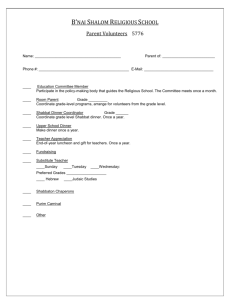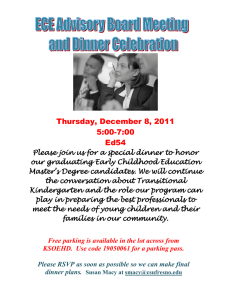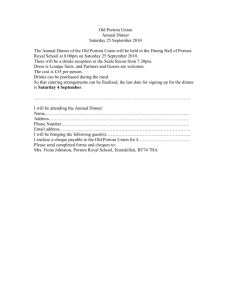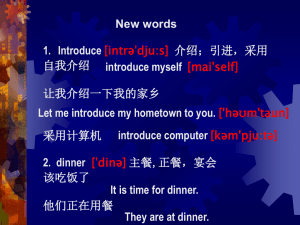Can Common Sense uncover cultural differences in computer applications?
advertisement
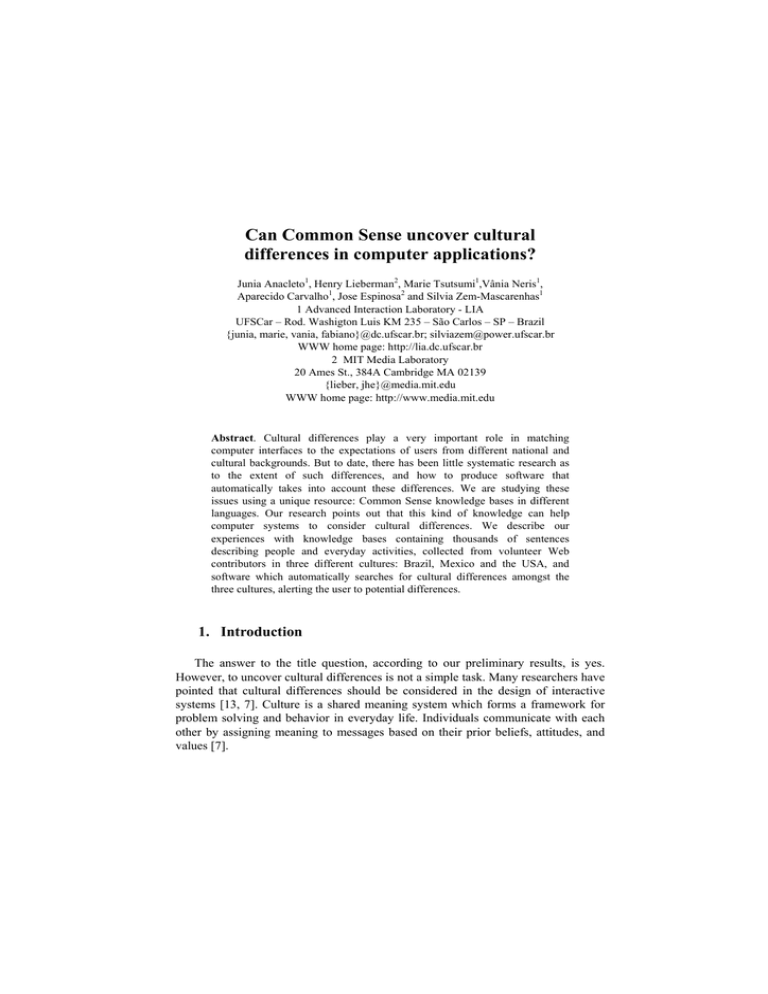
Can Common Sense uncover cultural
differences in computer applications?
Junia Anacleto1, Henry Lieberman2, Marie Tsutsumi1,Vânia Neris1,
Aparecido Carvalho1, Jose Espinosa2 and Silvia Zem-Mascarenhas1
1 Advanced Interaction Laboratory - LIA
UFSCar – Rod. Washigton Luis KM 235 – São Carlos – SP – Brazil
{junia, marie, vania, fabiano}@dc.ufscar.br; silviazem@power.ufscar.br
WWW home page: http://lia.dc.ufscar.br
2 MIT Media Laboratory
20 Ames St., 384A Cambridge MA 02139
{lieber, jhe}@media.mit.edu
WWW home page: http://www.media.mit.edu
Abstract. Cultural differences play a very important role in matching
computer interfaces to the expectations of users from different national and
cultural backgrounds. But to date, there has been little systematic research as
to the extent of such differences, and how to produce software that
automatically takes into account these differences. We are studying these
issues using a unique resource: Common Sense knowledge bases in different
languages. Our research points out that this kind of knowledge can help
computer systems to consider cultural differences. We describe our
experiences with knowledge bases containing thousands of sentences
describing people and everyday activities, collected from volunteer Web
contributors in three different cultures: Brazil, Mexico and the USA, and
software which automatically searches for cultural differences amongst the
three cultures, alerting the user to potential differences.
1. Introduction
The answer to the title question, according to our preliminary results, is yes.
However, to uncover cultural differences is not a simple task. Many researchers have
pointed that cultural differences should be considered in the design of interactive
systems [13, 7]. Culture is a shared meaning system which forms a framework for
problem solving and behavior in everyday life. Individuals communicate with each
other by assigning meaning to messages based on their prior beliefs, attitudes, and
values [7].
2
Junia Anacleto1, Henry Lieberman2, Marie Tsutsumi1,Vânia Neris1, Aparecido
Carvalho1, Jose Espinosa2 and Silvia Zem-Mascarenhas1
The cultural differences express the “world vision” a group of people have. This
vision is expressed in the simple activities that people do everyday. Arguably the
most general and widely applicable kind is knowledge about the everyday world that
is possessed by most people in a given culture — what is widely called ‘common
sense knowledge’. While ‘common sense’ to the ordinary people is related to ‘good
judgment’ as a synonymous, the Artificial Intelligence community uses the term
`common sense` to refer to the millions of basic facts and understandings that most
people have. For example, the lemon is sour; to open a door, you must usually first
turn the doorknob; if you forget someone’s birthday, they may be unhappy with you.
Common sense knowledge, thus defined, spans a huge portion of human
experience, encompassing knowledge about the spatial, physical, social, temporal
and psychological aspects of typical everyday life. Common sense is acquired from
the interaction with the environment. Changing the environment changes the
perception of common sense and is one of the reasons why different and diverse
cultures exist. This conception of common sense is building ontology about everyday
life based on the shared experiences of a community [12].
The challenge is to try to represent cultural knowledge in the machine, and have
interfaces that automatically and dynamically adapt to different cultures. While fully
implementing this goal is still out of reach, this paper takes some first steps.
We have collected large knowledge bases representing Commonsense knowledge
in three cultures: Brazil, Mexico and the USA. Comparison between these
knowledge bases gives us a basis for automatically discovering differences between
cultures, and finding analogies from one culture to another. Software for cultural
comparison is useful in many contexts. For example, by those who want to develop
systems focusing on a specific user group (e.g. a teacher who consults the common
sense database to prepare a specific instructional content); by those who want to
develop systems which use the cultural knowledge stored in the knowledge bases
(e.g search engines that consider the context); and by those who want to facilitate
communication between people, providing mutual knowledge about their cultures.
In this context, the main purpose of this work is to evaluate how the cultural
differences can be recognized in the databases that store common sense. For that, we
select a theme that frequently appeared in the Brazilian knowledge base – food.
Considering that eating habits express culture (F1) and common sense affects eating
habits (F2), we could say that common sense expresses culture. F1 is taken as true
and so we should demonstrate F2.
It is important that the reader understands that we make no claim to have fully
described a national culture, or to have fully captured cultural differences. Instead,
the goal is simply to get some useful representation of culture and common
knowledge, where otherwise the computer would have none. We believe that our
contribution is the first attempt to systematically study the extent and nature of
cultural differences; to represent cultural differences in machine-readable form; and
to present an example of software that searches for such differences and provides
inter-cultural translations automatically.
The next section presents how data are collected in the Open Mind Common
Sense (OMCS) knowledge bases. To give the reader some idea of how knowledge in
the various databases compares, we present some example comparisons for the food
Can Common Sense uncover cultural differences in computer applications?
3
domain. We then discuss the prototype agent for finding cultural differences,
followed by conclusion and future work.
2. The Open Mind Common Sense Approach for Gathering
and Using Common Sense Facts
Arguably the most general and widely applicable kind of knowledge about the
everyday world is the knowledge we typically assume is possessed by ordinary
people in a given culture — what is widely called ‘common sense knowledge’. One
way that AI has used to represent this knowledge is by simple sentences asserting
such facts (pioneered by Doug Lenat's CYC project). For example, a lemon is sour;
to open a door, you must usually first turn the doorknob; if you forget someone’s
birthday, they may be unhappy with you. Common sense knowledge, thus defined,
spans a huge portion of human experience, encompassing knowledge about the
spatial, physical, social, temporal and psychological aspects of typical everyday life.
Since every ordinary person has the common sense that computers lack, why not
involve everyone in building the knowledge base that is necessary to give computers
what they need to be able of common sense reasoning? Nowadays, it is easy to reach
lots of people through the Internet. For gathering the common sense data some Open
Mind Common Sense websites were built. As the name suggests, the Open Mind
Common Sense (OMCS) sites are open. Everyone who wishes to help can contribute
with his or her knowledge.
The data are stored in the OMCS database as simple statements in natural
language. However, for machine use, it is necessary to put them in a representation
that allows machines to make practical inferences and analogies. For that, the data
are submitted to a natural-language parser that generates a set of normalized nodes
that are semantically related, composing a semantic network. A better understanding
about how this semantic network is generated is presented by Liu [12].
Once the semantic network is ready, applications can be developed using the
common sense knowledge provided by different users.
Figure 1. Common Sense sentences from Portuguese- and English-speaking contributors
4
Junia Anacleto1, Henry Lieberman2, Marie Tsutsumi1,Vânia Neris1, Aparecido
Carvalho1, Jose Espinosa2 and Silvia Zem-Mascarenhas1
3. Common Sense and Eating Habits
In this section, we give the reader a glimpse of what can be compared between
the sites. Again, the idea is not to present a definitive scientific survey about such
issues as what people actually eat for breakfast in Brazil versus the USA. The
knowledge, after all, comes from members of the general public who may have
legitimate disagreements or differing experiences about these issues. The idea is that
Common Sense collects plausible (rather than completely accurate) answers about
these questions, which can lead to plausible assumptions about cultural differences.
Considering the redundancies in our data, we selected categories that appeared in
higher frequency in each base. Some of these data were presented in [1]. The
categories are presented bellow.
Time for meals
One of the most common themes in the knowledge bases is time for meals. Table
1 shows what is considered common sense for most of the collaborators.
Table 1.Time for meals.
Lunch
Dinner
Brazil
11:30 to 13:00
18:30 to 20:00
Mexico
14:00 to 16:00
20:00 to 21:00
USA
12:00 to 14:00
18:00 to 19:00
Here it is interesting to note that meals in Mexico are the latest ones. Although in
Brazil and the USA, meals happen at a similar hour, in Mexico it seems to be
common to have lunch after 14:00.
What do people eat in each meal?
Differences between what is eaten in each meal also can be noticed. Table 2
shows what seems to be considered common sense about what to eat in each meal.
It is possible to notice that Brazilian people prepare lighter food at breakfast.
Also Mexican people seem to like food make with flour. Concerning desserts,
Brazilian people associate ice cream as something cooling, and are reluctant to eat it
in Brazil's (relatively mild) winter. On the other hand, American people seem to
prefer pies and other baked desserts.
Table 2. What do they eat in each meal?
Breakfast
Brazil
bread
Lunch
rice,
beans,
meat,
salad, egg
Dinner
rice and
Mexico
tamales, eggs
with hot sauce
chicken with
mole, roast
meat, pastries,
chilaquiles,
barbacoa, tacos
tamales and
USA
pancakes,
bagels
hamburger, hot
dog, pizza,
sandwiches
steak and eggs,
Can Common Sense uncover cultural differences in computer applications?
beans,
soup,
salad,
sandwich
Dessert
ice cream,
fruit,
candy
atole,
quesadillas,
coffee and
cookies, bread
with bean
rice with milk,
churros with
chocolate, nuts
with honey
(crowbar),
sweet coconut
5
baked chicken,
clam chowder,
mashed
potatoes
pumpkin pie,
apple pie, ice
cream, cheese
cake
Food for special occasions
Christmas and parties were topics that collaborators remembered too. Table 3
shows the main types of food cited for this occasions. It is interesting to notice that in
Brazil and México it seems to be common have salty food for Christmas while in the
USA sweet dishes seem to be more appreciated. On the other hand, beer seems to be
appreciated at parties in all three countries.
Table 3. Food for special occasions.
Party
Christmas
Brazil
snack, candy,
cake, meat,
beer
turkey, pork,
lamb
Mexico
beer, tequila
USA
beer, vodka
romeritos,
codfish,
spaghetti
cranberry
sauce,
pineapple
salad, frozen
Christmas
Pudding
4 Using Cultural Knowledge in Interactive Applications
We believe the cultural differences stored in the common sense bases can be
helpful in (a) helping those who want to consider these differences in the
development of interactive systems; (b) facilitating the interaction of different users
by applications that use this common sense; and (c) facilitating the communication
between people. Here we point out how developers involved in the situations cited
above can use the cultural differences stored in common sense knowledge bases.
Developing systems considering cultural differences: Human Computer
Interaction research raises further questions about how to understand culture and
how it can and should affect user-interface design. Attributes as attraction,
dynamism, activity, level of expertise, faith, intentions, locality, social validation,
preferences, and scarcity have different weightings in different cultures [2].
Consequently, user-interface developers face further challenges [13]. Many
questions still persist while talking about considering cultural differences in the
6
Junia Anacleto1, Henry Lieberman2, Marie Tsutsumi1,Vânia Neris1, Aparecido
Carvalho1, Jose Espinosa2 and Silvia Zem-Mascarenhas1
design of interactive systems. Marcus [13] raises some questions: Are our notions of
usability culturally biased? How should culture differences relate to persuasion and
establishment of trust in Web sites and Web-based applications? How should culture
dimensions relate to established dimensions of intelligence and change your thinking
about online help, documentation, and training? How do culture differences relate to
new insight about cognition differences? Do these differences change your thinking
about user search strategies, mental models, and navigation? The only consensus
seems to be that these attributes have different values and are key characteristics of
the cultures to which they belong [4]. Despite the importance of these questions,
some developers still face an uphill battle to get budgets for culture-oriented research
and development accepted, to find and allocate the human resources, and to achieve
project success [13]. In this context, collecting these “world views” and making them
available for everyone that wants to develop a user-interface, can be expensive and
laborious. The use of the Internet and the collaboration of millions of people allow
knowledge bases to reflect actual cultural knowledge without cost, as anyone can
have access to the database at the sites.
Developing systems which consider cultural differences: As the complexity of
computer applications grows, it may be that the only way to make applications more
helpful and avoid stupid mistakes and annoying interruptions is to make use of
common sense knowledge. Cellular telephones should know enough to witch to
vibrate mode if you’re at the symphony. Calendars should warn you if you try to
schedule a meeting at 2 AM or plan to take a vegetarian to a steak house. Cameras
should realize that if you took a group of pictures within a span of two hours, at
round the same location, they are probably of the same event [8]. In the web context,
the necessity of using common sense knowledge becomes even more evident. The
number of web pages available on Internet increases day after day, and consequently,
finding relevant information becomes more and more a difficult task [3]. Also, Web
Search tools do not do a very good job of discerning individuals’ search goals [16].
However, when we consider communities of people with common interests, it is
possible to improve the quality of the query results using knowledge extracted from
common sense databases and observing behaviors of people of same culture. When a
user submits a query, the cultural aspects suggest specific information exploiting
previous observations about the behavior of other users when they asked similar
queries. Different users may merit different answers to the same query [3]. As
cultural differences can be detected in common sense bases, search engines that
attempt to leverage common sense have a great opportunity to reflect cultural
differences in their results.
Developing systems which facilitate communication between people by
showing cultural differences: Communication between people from different
cultures is a field which presents many interesting aspects. To show that common
sense can help showing the cultural differences, a prototype of a mail client was
developed. The application has an agent that keeps watching what the user is typing,
while makes commentaries on the differences in the grounding that can lead to
possible misunderstandings. The system also uses these differences to calculate
analogies for concepts that evoke the same social meaning in those cultures. We
focus this prototype on the social interaction among people in the context of eating
Can Common Sense uncover cultural differences in computer applications?
7
habits, but it could scale to other domains. The system’s interface has three sections,
as can be seen in Figure 2. The first one – at the upper left – is the information for
the email addresses and the subject, the second one – at the upper right – is where the
agent posts its commentaries about the cultural differences and the third part – the
lower part – is the body of the message. The second section has four subsections: the
upper one shows the analogies that the agent found and the other three show the data
that are not suitable for analogy. For example, in our screen shot, the third label for
the Mexican culture – Mexicans thinks that dinner is coffee and cookies – and the
second for American culture – Americans think that dinner is baked chicken – cannot
make a meaningful analogy even if they differ only in one term.
Dinner is for Brazilians what lunch is for Mexicans
Dinner is for Americans what dinner is for Brazilians
Brazilians think that dinner is rice and beans
Brazilians think that dinner is salad, meat and potatoes
Brazilians make dinner between 6:30 and 8:00 PM
Brazilians think dinner is soup
Mexicans think that dinner is quesadillas
Mexicans make dinner between 8:00 and 9:00 PM
Mexicans think that dinner is coffee and cookies
Mexicans think that dinner is bread with beans
Americans thinks that dinner is steak and eggs
Americans think that dinner is bake chicken
Americans think that dinner is smash potatoes
Americans make dinner between 6:00 and 7:00 PM
jhe@media mit ed
junia@dc ufscar b
Dinner
Dinner is for Brazilians what lunch is for Mexicans
Dinner is for Americans what dinner is for Brazilians
Brazilians think that dinner is rice and beans
Brazilians think that dinner is salad, meat and potatoes
Brazilians make dinner between 6:30 PM and 8:00 PM
Brazilians think dinner is soup
Mexicans think that dinner is quesadillas
Mexicans make dinner at time between 8:00 PM and 9:00
Mexicans think that dinner is coffee and cookies
Mexicans think that dinner is bread with beans
Americans thinks that dinner is steak and eggs
Americans think that dinner is bake chicken
Americans think that dinner is smash potatoes
Hi Junia,
I am going to have a dinner next Friday in my place.
Figure 2. A screen shot of the system.
In order to make the cultural analogies, the system uses four semantic networks.
The OMCSNet [10] semantic network (OMCSNet.OM), which was mined from the
Open Mind corpus, is used as the core engine because it provides tools for context
expansion and is especially designed for working with Open Mind Common Sense
databases. The other three databases are culturally specific; they have knowledge
about the Brazilian, Mexican and North-American culture – these semantic networks
are called OMCSNet.BR, OMCSNet.MX and OMCSNet.US respectively. The
OMCSNet.BR was built from data mined from the Brazilian Open Mind Common
Sense database. In the American and Mexican cases, the statements were already in
English language. In the Brazilian case, the statements were originally in Portuguese.
For this project, a small group of statements related to eating habits were selected
and freely translated to English to be parsed.
The calculation of cultural analogies is divided into eight steps.
Data retrieval (step 1): The first thing that the system does is to use the NLP
package MontyLingua [9] to get the relevant concepts of the mail. This information
is presented as tuples of (verb subject direct_object indirect_object). In the example
above, the NLP tool produces the output (“have” “I” “dinner” “my place”).
8
Junia Anacleto1, Henry Lieberman2, Marie Tsutsumi1,Vânia Neris1, Aparecido
Carvalho1, Jose Espinosa2 and Silvia Zem-Mascarenhas1
Context retrieval (step 2): Then, we use each direct and indirect object of the
tuples from the previous step to query the OMCSNet.OM for the relevant concepts.
Querying this network first gives us some query expansion of “culturally
independent” relations. That is, the base OMCSNet.OM, as our largest and most
diverse collection, is taken as the “standard” to which the other databases are
compared. Since OMCSNet.OM itself has some cultural bias, it would be better,
once we have collected enough knowledge bases in other languages, to create a
“worldwide” knowledge base by removing all culturally-specific statements, as a
basis for comparison. The result of this query is used to get the context in the
culturally specific nets. At the end of this stage the output was ranked using two
criteria: the first one prefers the concepts resulting for the cultural databases, and the
second is to rank first the concepts that come from the part of the email that the user
has just written. This helps to address the relevance effectively by giving preference
to the important topics of each culture, and in the recent topics of the mail. This
process brings concepts as lunch, food, meal, and salad, that are in the semantic
neighborhood of dinner.
Node retrieval (step 3): In this step, we get the tuples whose nodes are in the
context of the mail from OMCSNet.MX and OMCSNet.US. The output of this step
is the pieces of common sense knowledge for the Mexican and American culture (see
Figure 3). At this point we have everything the databases have about the eating
habits in both cultures. For example: the output from OMCSNet.MX has the
following, among others: ['TakeTime', 'dinner', 'between 8:00 PM and 9:00 PM'],
['KindOf', 'dinner', 'light meal'], ['IsA', 'dessert', 'rice with milk'], ['IsA' 'food'
'chocolate']; and from OMCSNet.US has: ['TakeTime', 'dinner', 'between 6:00 PM
and 7:00 PM'], ['KindOf', 'dinner', 'heavy meal'], ['IsA', 'dessert', 'pumpkin pie'],
['IsA' 'food' 'chocolate'].
Relevance of the nodes (step 4): By comparing each node with the cultural sets
of knowledge in the previous step we can get its relevance. For this operation, the
SIM operation from Cohen's WHIRL [12] is used, as in Figure 4. The interesting part
about WHIRL is that it is a system that effectively interleaves inference with
retrieval. This operation allows getting the similarity for each node in one set with all
the elements of the other set and always maps to a number between zero and one.
Calculation of analogies (step 5): If the value of one node and the semantic
relations in the tuples of one set are equal to the tuples of the other cultural set, then
the unmatching concept is an analogy between the two cultures that are being
considered. In addition, the semantic relation is analyzed in order to avoid irrelevant
analogies. These analogies are ranked using the similarity between the two nodes. If
two different pairs of tuples allow the same analogy, the values of the relevance
scores are added. In our example set, the only nodes that are suitable for analogy are
the nodes that talk about the ‘KindOf’ meal the dinner is in both cultures. This
process is similar to Dedre Gentner’s classic Structure Mapping analogy method.
Calculate the nodes to display (step 6): The nodes are sorted using the
relevance of their context and their similarities produced by the SIM operator.
Can Common Sense uncover cultural differences in computer applications?
9
BR
OMCSNet.BR
MX
Context
OMCSNet.MX
US
OMCSNet.US
Get nodes
Cultural
knowledge
Figure 3. The node retrieval operation.
Chose the information to display (step 7): The nodes ranked higher are chosen
to be displayed. First, we choose the nodes to calculate analogies and then the rest of
the nodes, the former nodes give information about things that are different, but do
not have a counterpart in the other culture, or are grounding information that makes
no sense for an analogy [6].
MX
WHIRL
Analogies
BR
WHIRL
Analogies
US
Figure 4. Calculation of the relevance and the analogies.
Map the concept to English (step 8): For each semantic relation in the net, a
custom template that maps its information to English sentences was created and
applied before displaying the information. For the analogies, an additional template
is used to explain why the system made this analogy. In Figure 2 we show only the
top four concepts that are displayed after applying the template.
5. Conclusions and Future Works
This work has presented some first steps in the modeling and use of cultural
differences in interactive applications. This way, we answer affirmatively to the
question proposed in the title of this paper. We model cultural differences by
comparing knowledge bases of Commonsense statements collected from volunteer
Web contributors in various cultures. We explore applications by those who want to
focus on a specific user group; by those who want to develop systems which use the
cultural knowledge stored in the knowledge bases; and by those who want to
facilitate communication between people, providing mutual knowledge about their
cultures. This work is part of a larger effort to model Commonsense knowledge. In
10
Junia Anacleto1, Henry Lieberman2, Marie Tsutsumi1,Vânia Neris1, Aparecido
Carvalho1, Jose Espinosa2 and Silvia Zem-Mascarenhas1
[8], we present many applications that have built using the OMCS, ConceptNet, and
related tools, for providing intelligent defaults in interactive systems and mapping
from user goals to actions. Future work will also include the investigation of cultural
expressions in Open Mind Common Sense considering a larger number of facts. Also
other domains will be studied in order to verify the cultural differences besides
eating habits domain. While we have not yet conducted formal user tests with the
email application, informal feedback from users shows that, while the absolute
accuracy of suggestions is not high, users do appreciate the occasional useful
suggestion and it is not excessively distracting even when suggestions are not
relevant. We hope developers of interactive systems use the knowledge about culture
stored in Open Mind Common Sense databases in order to facilitate the interaction
between humans and computers.
References
1. Anacleto, J.; Lieberman, H; Tsutsumi, M.; Neris, V.; Carvalho, A.; Espinosa, J.; ZemMascarenhas, S. Using Common Sense to Recognize Cultural Differences. Submitted as a
work-in-progress paper to CHI 2006.
2. Bailey, B.P., Gurak, L.J., and Konstan, J.A. An examination of trust production in
computer-mediated exchange. Proc. 7th Human Factors and the Web 2001 Conference
www.optavia.com/hfweb/7thconferenceproceedings.zip/bailey.pdf. Last visited in Jan, 06.
3. Birukov, A., Blanzieri, E, Giorgini, P. Implicit: An AgentBased Recommendation System
for Web Search. Proc. AAMAS’05 (July 25-29,2005, Utrecht, Netherlands).
4. Choi, B., Lee, I., Kim, J., Jeon, Y. A Qualitative Cross-National Study of Cultural
Influences on Mobile Data Service Design. Proc. CHI 2005.
5. Cohen, William W. WHIRL: A word-based information representation language. Artificial
Intelligence (2000) 163-196.
6. Falkenhainer, B., Gentner, D. The Structure-Mapping Engine. Proceedings of the Fifth
National Conference on Artificial Intelligence. (1986)
7. Khaslavsky, J. Integrating Culture into Interface Design. Proc CHI 1998 p 365-366.
8. Lieberman, L., Liu, H., Singh, P., Barry, B. Beating Common Sense into Interactive
Applications. American Association for Artificial Intelligence, Winter 2005, p 63-76
9. Liu, Hugo. MontyLingua: An End-to-End Natural Language Processor for English. (2003)
10. Liu, Hugo and Singh, Push. OMCSNet: A Commonsense Inference Toolkit. MIT Media
Lab Society Of Mind Group Technical Report SOM02-01. (2002) 272-277.
11. Liu, H.; Singh, P. Commonsense Reasoning in and over Natural Language. Proc. 8th KES
04. http://web.media.mit.edu/~push/CommonsenseInOverNL.pdf. Last visited in Jan, 06.
12. Liu, H; Singh P. ConceptNet: A Practical Commonsense Reasoning Toolkit. BT
Technology
Journal,
v.
22,
n.
4,
p.
211-226,
2004.
http://web.media.mit.edu/~push/ConceptNet-BTTJ.pdf. Last visited in Jan, 06.
13. Marcus, A. Culture Class vs. Culture Clash. Proc. Interactions 2002 (June, 2002), 25 p.
14. Singh, P. The OpenMind Commonsense Project. KurzweilAI.net, 2002. Available in: :<
http://web.media.mit.edu/~push/OMCSProject.pdf>. Last visited in Jan, 06.
15. Spink, A., Ozmutlu S., Ozmutlu H.,Jansen B. J. U.S. VERSUS EUROPEAN WEB
SEARCHING TRENDS. SIGIR Forum. Fall 2002, Vol. 36, No. 2, p 32-38
16. Teevan, J., Dumais, S. T., Horvitz, E. Personalizing Search via Automated Analysis of
Interests and Activities. Proc. SIGIR ’05 (August 15–19, 2005, Salvador, Brazil).


